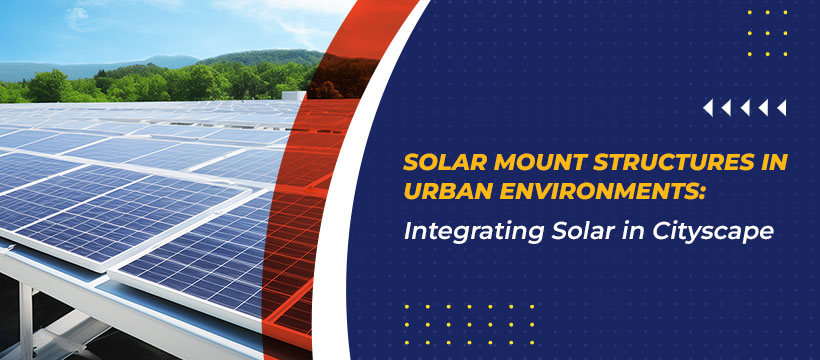Solar Mount Structures in Urban Environments: Integrating Solar in Cityscapes

Solar Mount Structures in Urban Environments: Integrating Solar in Cityscapes
In urban environments, the demand for energy is growing fast, and environmental concerns are coming to the forefront. But the integration of solar power can be a promising solution. As cities are expanding, finding sustainable ways to harness renewable energy in the urban landscape has become very important. In this article, we will explore the challenges, designs, and transformative impact these structures can have on cityscapes. Let’s find out some challenges that solar integration faces in an urban environment.
Challenges in Urban Solar Integration
Implementing solar solutions in urban environments can have a myriad of challenges. Starting with limited space, aesthetic considerations demand innovative solutions to make solar integration feasible in the city environment.
There are very limited open areas in urban environments, and this poses a significant obstacle to traditional solar installations. Tall buildings and other structures cast shadows that impact the efficiency of the solar panels. Integrating solar solutions into urban landscapes needs a balance between functionality and aesthetics.
Overcoming these challenges requires innovative solutions such as rooftop installations and other creative designs that can utilise the available space very efficiently and can also address aesthetic and shading concerns.
Solar Mount Structures Overview
In the realm of urban solar integration, there are a variety of solar-mounted structures that cater to the unique challenges of cityscapes. Ground-mounted structures are for open places so that they can get the maximum sunlight. Rooftop installations decentralised energy production and integrated solar solutions, seamlessly integrating solar technology into urban infrastructure. Building-Integrated Photovoltaics, or BIPV, incorporates solar materials into windows and walls. It’s vital to ensure that the structure is stable and can withstand wind, rain, and moderate earthquakes.
Types of Solar Mount Structures
To get better production, you need the proper mounting structure. The investment in a mounting structure is a single-time investment, and the decision to buy it should not be taken lightly. There are five primary types of solar mounting structures, such as RCC roof mounts, ground mounts, top-of-pole mounts, side-of-pole mounts, and tracking structures. Here is some detailed information about the various solar mounting structures.
RCC roof mounts
These types of mounts help keep the wires from running distances between solar arrays and inverters to a minimum. Roof mounts require a large space for installation, and these panels can be fixed and installed with solar trackers.
Ground mounts
Ground mounts are solar structures that are used for the installation of solar panels on the ground. These mounts are very adjustable and can be inclined up or down to absorb maximum solar energy at different times of the day. These types of structures are used to secure locations in clean environments.
Top-of-pole mounts
As the name implies, these racks are mounted on poles. These poles allow the solar panels to be mounted on the pole’s top. They also help the mounting poles to be settled onto the ground and fitted with concrete before the solar modules are attached to the top of the pole.
Side-of-pole mounts
In side-of-pole mounts, the solar panels are mounted on the pole’s side. These mounts are made up of a small number of modules that are used to make solar panels. Side-of-pole mounts are especially for remote lighting systems.
Tracking structures
These mounts are used for all types of solar tracking systems. A solar tracker is an automatic system that aids in tracking the position of the sun throughout the day for optimal solar energy. Solar trackers boost energy, but they are rarely used as they are very expensive.
Benefits of solar integration in multi-story buildings
Integrating solar-mounted structures into multi-story buildings can be really beneficial. Rooftop solar installations utilise the unused space. It optimises energy production without occupying additional space. If you install solar-mounted structures on both residential and multi-story buildings, then it can contribute to substantial cost savings on electricity bills. Also, buildings with solar installations reduce their carbon footprint, which contributes to environmental sustainability.
Incorporating solar solutions aligns with green building standards, which enhances the building’s overall environmental certification. Solar installations on multi-story buildings can raise awareness about renewable energy, which will make the community more environmentally aware.
The integration of solar mount structures in urban environments stands as an important step towards a sustainable and energy-efficient future. As cities worldwide continue to grow and evolve, the importance of clean energy sources has become evident. The journey towards a solar-powered cityscape is not just about meeting energy demands; it is about creating environmentally conscious communities. As we navigate the complexities of modern city life, integrating solar solutions has become a beacon of hope. The future of our cities is bright. For more information and/or to get a quote, contact us.

